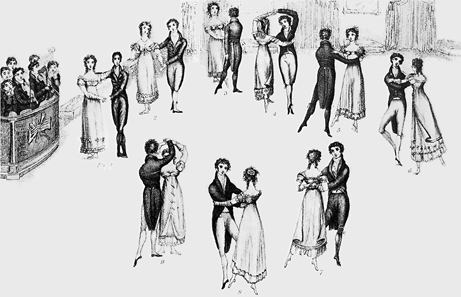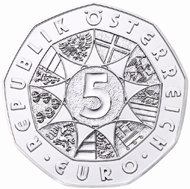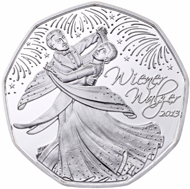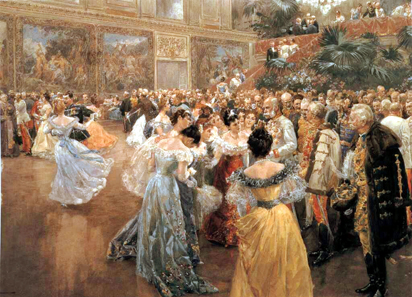December 13, 2012 – On December 12, 2012 the Austrian Mint will issue a 5 euro silver coin celebrating one of the best-known dances of all time, the Waltz.
The reverse of the coin depicts a delightful couple in full swing, dancing the graceful waltz. Dressed in elegant full ballroom dress, the lady’s full skirt and scarf-trimmed arms emphasize the swish of their move to the music. Perfectly in step with her, the gentleman is shown in full tux and tails with the swing of the tails also highlighting their movement. It is easy to imagine being there in person as the couple gracefully waltzes by in three quarter time. In the background are the twinkling stars and fireworks, all adding to the festive atmosphere of a waltz. Also on this side of the coin are the words “Wiener Walzer”, or “Viennese Waltz” engraved into the design in a lyrical style. This side of the coin was designed and engraved by the Mint’s chief engraver Thomas Pesendorfer.
The obverse of the nine-sided coin is the standard 5-euro design, with the denomination encircled by the shields of the nine federal provinces of Austria. In the center is the face value of 5 euros. Mint engraver Helmut Andexlinger designed the obverse.
Detail from frontispiece to Thomas Wilson’s Correct Method of German and French Waltzing (1816), showing nine positions of the Waltz, clockwise from the left (the musicians are at far left). At that time, the Waltz was a relatively new dance in England, and the fact that it was a couples dance (as opposed to the traditional group dances), and that the gentleman actually clasped his arm around the lady’s waist, gave it a dubious moral status in the eyes of some. Source: Wikipedia.
Early mentions of dance movements relating to the waltz date back as far as the 16th century. But it was not until the late 17th century in the imperial court of Vienna that an early form of the waltz really took hold. Starting out as a simple 2 beat step it evolved into the more complicated but very graceful 3/4 time. In the 18th century in southern Germany and Tyrol the less graceful but probably more fun dance called the Laendler that swooped couples around the dance floor was very popular. In the late 18th century the two forms of dance merged and the nobles dropped the more sedate minuet in favour of the early form of the waltz. The stately imperial court succumbed to the scandalous requirement of the closed position with your partner in order to waltz together, which was simply not done during a dance in earlier years. The Viennese Waltz, with its light and fast in style, made it more fun to participate in a stately and reserved environments, helping to spread its popularity in the late 18th century all over Europe. Huge dance halls that could hold thousands of dancers at a time were constructed and some social commentators even consider the Viennese Waltz to be the most important ever development in the history of dancing. Thanks to the recent renaissance in ballroom dancing around the globe, though more than 200 years old, the dance is still very much alive and well today.
A ball at the imperial court in Vienna, by Wilhelm Gause, 1900. Historisches Museum der Stadt Wien. Source: Wikipedia.
Austria is of course also famous for Johann Strauss known as the “Waltz King.” He composed several hundred waltzes at a time when the waltz was very popular. Most famous is probably the Blue Danube Waltz, known the world-over as the encore finale performed every New Year’s eve during the Vienna Philharmonic Orchestra’s New Year’s Eve worldwide concert. Within Austria this waltz is played at the stroke of midnight on radio stations and television channels to ring in the New Year. In some ways it has become Austria’s unofficial national anthem.
The 5 euro silver coin has a diameter of 28.5 mm, contains 8 grams of fine silver, a total weight of 10 grams and has a fineness of 800. The coin is available only in special uncirculated quality and will have a maximum mintage of 50,000. Of this total mintage, and for the first time ever, 5,000 coins will be available in an English-only package. The remaining 45,000 will be available in a German-only folder. Each of these coins is vacuum-packed in a colorful, informative and winter-themed blister pack.
The 300,000 copper coins struck by the Austrian Mint for circulation in Austria will only be available through the Austrian banking network.
For more information on this coin visit the website of The Austrian Mint.
Listen to the famous Blue Danube Waltz!
To see how popular waltz dancing is in Austria, watch this video clip: a waltz flashmob against discrimination and extremism.
Really skilful dancers are these participants at the Vienna Waltz Vienna Regional Championship.
And if you don’t know how to dance the waltz you should watch this video to Learn to Dance Waltz.







